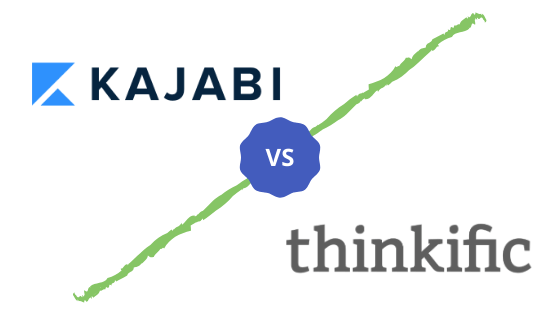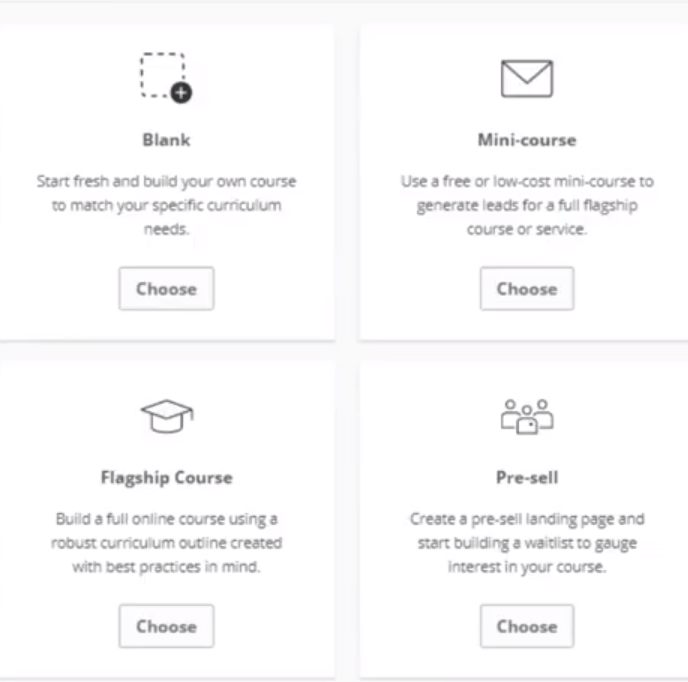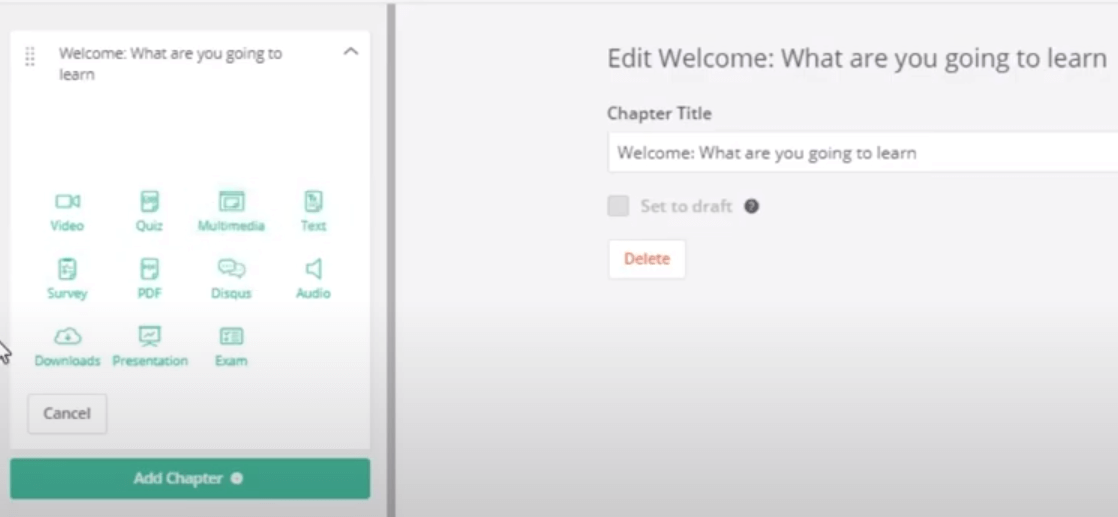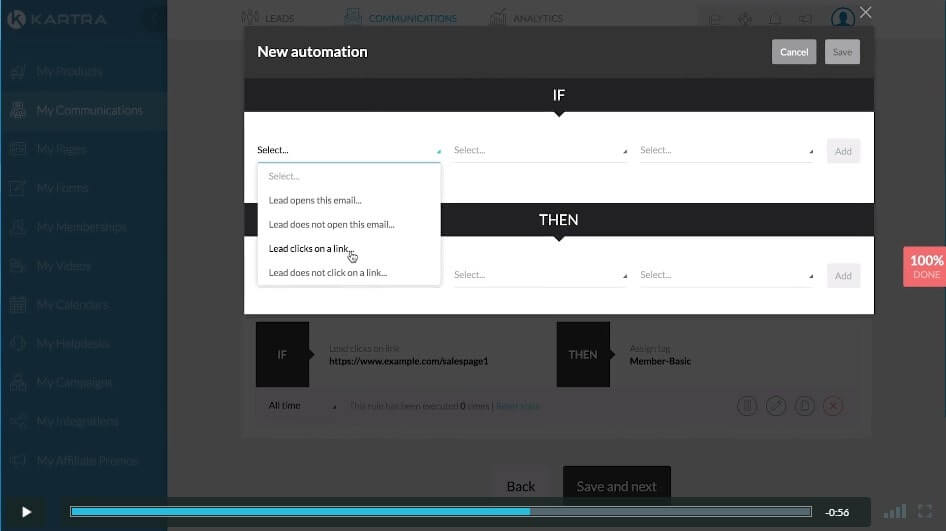Kajabi vs Thinkific: Side-by-Side Comparison

Looking for an in-depth guide that will help you make the smart choice between Kajabi vs Thinkific?
When it comes to building a successful online course business, it’s important to choose the right platform and tools.
There are a lot of factors to consider when choosing an online course platform, such as cost, features, ease of use, and support.
Undoubtedly, two of the best platforms to build and sell online courses are Kajabi and Thinkific.
Each of these platforms has its own unique set of features and benefits.
So, how do you choose between Kajabi vs Thinkific?
In this guide, we’ll compare Kajabi and Thinkific side-by-side so you can make an informed decision about which platform is right for your business. We’ll tell you about the pros and cons of each, compare features, and give our thoughts about who the ideal user is for each online course platform.
This guide has been totally updated to include the latest features and pricing so you can make an informed decision.
For a limited time, we have secured a special deal to extend Kajabi’s free trial from 14 days to 30 days for our readers. If you are interested in this offer, click here for registration details.
What are Kajabi and Thinkific?
Kajabi and Thinkific are the two most popular cloud-based online course builders and membership sites.
Both these online course platforms offer a ton of features for course creation, delivery, membership, and marketing tools. They are designed to deliver content in many formats such as videos, quizzes, questions and answers, pdf, podcasts, and more.
The biggest appeal of both these tools is they are easy to set up and use, so you can focus your resources on course creation and marketing, allowing you to build and sell online courses without hassle.
A major difference between the two online course platforms is that Kajabi offers support for marketing whereas Thinkific is more focused on just content creation.
Let’s take an in-depth look into some of the key features of both these tools.
Access Your Free Kajabi Strategy Meeting
Following the steps below, you can secure a free 1:1 strategic session with a member of the Kajabi Customer Success team to help build your business on Kajabi.
Step 1: Sign up for your free Kajabi trial by clicking on this link or other links on this page
Step 2: You’ll get an email from us providing instructions on how to schedule your free Success Session.
Step 3: Schedule Session with a Kajabi expert and use their knowledge to create a personalized action plan for your business.
Online Course Creation
Top-notch content and its delivery are the key success factors of online courses and both these platforms score well on this aspect.
Kajabi and Thinkific are similar in that they offer a simple drag-and-drop interface to create online courses, so no prior technical experience is required to set up your online course through these platforms. Your Kajabi and Thinkific subscription include video hosting as well.
Let’s compare how each platform fairs as a course builder below:
Kajabi
Kajabi allows you to create a wide range of content such as:
- Mini-course – A quick course to give a glimpse of your offering or business
- Online course – A comprehensive online course
- Evergreen training – Training sessions spread over a few weeks
- Membership – A membership-based content delivery
- Community – A social media platform for your members to interact
- Coaching program – A 12-week coaching program template

You can click on any of these links and Kajabi will create a blueprint for you. Alternatively, you can choose to work with a blank canvas if you prefer that.
Once you decide the content product, all that you have to do is click on the different sections and chapters and add your content.

Further, you can decide what type of content you want to give your members, edit them quickly, and even delete content at any time.

You can also bulk upload your content and Kajabi will divide them into lessons for you.
With such cool features, you have complete control over your content, and Kajabi’s simple and intuitive interface makes it easy to manage your content at all times.
Thinkific
Moving on to Thinkific, it scores high on the ease of content creation as well. Like Kajabi, you can use the course builder to create different kinds of content, though your options are restricted to just three.
- Mini-course – A free or low-cost course to market your other products and to generate leads
- Flagship course – A comprehensive online course
- Pre-sell – This landing page allows you to gauge interest in your course.
And of course, you can start with a blank page as well and build it the way you want.

You can easily add chapters and present them in many formats such as videos, quizzes, surveys, PDFs, presentations, and more.

You can also add bulk lessons and Thinkific will separate them into modules for you. However, you can add only two levels of content, that is Lessons and Chapters. Unlike Kajabi, you can’t further modularize your content.
A handy feature in Thinkific is the Video Library that allows you to load videos once and use them across many lessons and courses.
It also offers many advanced features such as Captivate and Storyline, allows you to release content on pre-scheduled dates, provides completion certificates, and more.
Verdict
Overall, both these platforms make it easy to create online courses and upload content. There are minor variations such as the option to create sub-categories in Kajabi and a video library in Thinkific, so if you’re looking for such specific features, you can choose one over the other. In all, both are winners in this category.
Membership Site
Membership sites require members to login to access a mix of free and paid content such as online courses, live webinars, standalone content, video and audio tutorials, latest news and opinions, community forums, and more. Both Kajabi and Thinkific make it easy to create such membership sites.
Kajabi
Kajabi has a set of powerful tools to create a membership site within minutes. Here are some of its salient features.
- You can set up different membership levels and a different payment for each
- Allows you to customize content and add them to different membership levels
- Gives the choice to present your membership offer in the landing page
- You have the option to roll out content that’s specific to each membership level
- Help manuals on the Kajabi dashboard are comprehensive and address most common questions and doubts

Thinkific
Thinkific also has many important features that make it easy to set up and use a membership site, and some of them are:
- You can create multiple courses in a single package and set subscription prices for each membership level.
- Based on your content, you can add each bundle on your landing page.
- You can change the content to “private” at any time to keep them behind specific payment gateways
- Thinkific allows you to set up recurring payments through Stripe
- You have the option to set up a drip schedule so content is available to specific members on predetermined dates.
- Allows to link to your social media communities.

Verdict
Again, both the platforms are winners in this category since they come with some cool features to create and manage a membership site. But Thinkific scores over Kajabi as it is easier and less complicated to create a membership site on this platform.
Page builder and templates
Kajabi
Kajabi offers more than ten-player themes to customize your landing page and its look and feel can be changed based on the type of content you’re offering.
Each of these themes is well-designed and scores high on usability. It is professional in every sense and members can navigate through content easily. The best part is it can be customized without any coding.

Thinkific
Thinkific’s themes are also visually-appealing and user-friendly and they can be customized to meet your needs. But the downside is Thinkific offers only three themes, each with three or four styles, for a total of 12 theme and style combinations.
Also, customizing requires some knowledge of coding as it is based on a templating language called Liquid.

Verdict
Hands-down Kajabi is the winner given its theme choices and lack of coding for customization.
Payment processing and payouts
Both Kajabi and Thinkific are integrated with Stripe and PayPal, so your customers can pay through a credit card or PayPal account. You can log into your account at any time and request a payout.
A key difference is that Kajabi allows PayPal for all courses and membership content whereas Thinkific offers PayPal only for courses with a one-time payment and not for recurring courses or subscriptions.
This can be a major limiting factor if you have a membership site that requires regular payments.
Due to this difference, Kajabi scores over Thinkific, especially if your site requires periodic payments.
Quizzes/Assessments

Thinkific and Kajabi allow you to add different elements to your course content, such as
- Quizzes
- Assessments
- Videos
- Text
- Audio
- Multimedia
- Surveys
- Webinars
- Downloads
- Presentations
- Whitepapers
- Disqus, and more
Since both the platforms cover almost all the elements, both are winners in this category.
Analytics/Reporting
Both Kajabi and Thinkific provide useful information such as the net revenue, opt-ins, page views, subscriptions, and other relevant metrics on their respective dashboards.
You can even integrate both with Google Analytics to get information such as the source of your traffic, online behavior, conversions, actions on the page, and more.
Thinkific also integrates with Mixpanel, an analytics platform used to track user interactions with web and mobile applications.
The advantage is you get granular information such as an analysis of users’ actions on each page including the time they spent doing each action.
Mixpanel comes with other cool features as well to give you in-depth insights and behavior of your members.
Using this, you can customize your offerings to appeal to more people.
Due to this difference, Thinkific is the hands-down winner.
Affiliate program
Thinkific and Kajabi offer affiliate programs to help partners earn additional income.
Thinkific manages its affiliate program through a tool called PartnerStack and once approved, you can promote your content and earn a 20% commission on all monthly or annual plans paid by your subscribers.
Also, you get access to exclusive promotional content and a 90-day cookie period where a potential subscriber is tracked for 90 days and you get the referral fee if they subscribe within this period.
Kajabi has a more complex affiliate program. Besides a 30% lifetime commission, you also get special rewards commensurate with your progress. Also, Kajabi helps you to create customized affiliate and registration pages.
When you consider the two, Kajabi is the winner as it offers custom promotional material and the earnings are based on your performance.
Customer Support
Kajabi and Thinkific are more or less the same when it comes to customer support.
You can reach the representatives through phone, email, or live chat.
The difference is Kajabi offers 24X7 live chat whereas Thinkific has live chat only during business hours.
Alternatively, you can submit a ticket as well.
Integrations

Both the tools integrate with a ton of apps, especially the popular ones and this makes it easy to promote your content to a wide customer base.
They integrate well with marketing apps as well. Kajabi, for example, integrates natively with apps such as MailChimp and Aweber that help with email marketing.
Thinkific, on the other hand, integrates with ActiveCampaign and InfusionSoft to boost the marketability of your content.
Above everything, both the platforms connect with Zapier, which in turn connects with most apps available today.
Key Feature Differences
Kajabi scores over Thinkific in the following areas
- Creates marketing funnels automatically
- Integrates email marketing tools
- A simple checkout process that converts well
- Tracks abandoned customers and follow them up through email
- Sales Pipeline builder is a game-changer when it comes to marketing
- Many themes for your content
- Automatically adds or removes tags, creates a unique offer, and more.
Thinkific scores over Kajabi in these aspects.
- Better analytics/reporting
- It is a simple platform that focuses mainly on course creation
- Better value for money as it offers a free plan.
Pricing
Thinkific
Thinkific pricing comes across four tiers:
- Free – ideal for those who want to test waters
- Basic ($49/month) – provides basic features such as unlimited courses, reporting, and custom domain
- Start ($99/month) – offers powerful features to scale your business
- Grow ($199/month) – ideal to build an education empire.
Kajabi
Kajabi pricing is broken down to three plans:
- Basic ($149/month) – allows up to three courses and pipelines
- Growth ($199/month) – ideal for up to 15 courses
- Pro ($399/month) – supports 100 products and pipelines.
Conclusion
So, which tool is right for you?
Thinkific is a simple course creator tool that focuses only on content creation whereas Kajabi is a content creation and marketing solution that gives a ton of value for online marketers.
Choose Thinkific if you want to,
- Test the waters of course creation
- Bootstrap your business
- Create a course and make some money off your knowledge and expertise, without worrying about marketing
- Scale with your business growth
- Have advanced analytics
Choose Kajabi if you want to,
- Set up a full-fledged online course business or coaching programs
- Focus on the marketing side as well, and don’t mind paying extra money for it
- Have a good customer support
- Create visually-appealing landing pages and course content
- Have an all-in-one platform for your online business that can handle everything from course creation to marketing to funnel building and more
In reality, though, both Kajabi and Thinkific are similar in many ways. But for me, Kajabi was better because it helped to create custom courses with the best themes and helped to handle the end-to-end aspects of course creation including some great marketing features, even if I had to pay a little extra.
Other Online Course Platform Comparisons
- Podia vs Thinkific
- Kartra vs Thinkific
- Thinkific vs Teachable vs Kajabi
- Thinkific vs Udemy
- Teachable vs Thinkific
- Kartra vs Kajabi
- Samcart vs Kajabi
- Teachable vs Udemy
- Podia vs Teachable
- Podia vs Kartra
- Podia vs Learnworlds
- Kajabi vs Teachable
- Kajabi vs Podia
- Squarespace Courses vs Thinkific
- Squarespace Courses vs Podia
This post may contain affiliate links and we may earn commissions. Learn more in our disclosure.

